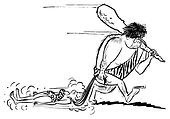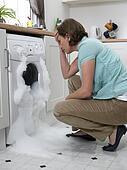by Mark Thornton
You can chart the course of human progress in terms of how clean our clothing is. In early times people used animal skins, had no change of clothing, and had no soap. By Adam Smith’s day soap had improved in quality, was produced industrially, and was becoming available to the common man.
produced industrially, and was becoming available to the common man.
In fact, the Industrial Revolution, which is usually discussed in terms of iron, steam, and factories, was actually all about bringing products like soap and underwear — previously only available to the rich — to the common peasants.
Only after WWII did electric automatic clothes washers displace hand-cranked machines. Then detergent replaced soap in the washing process, and competition resulted in much more effective products.
In 1956 the product Wisk was launched as the first liquid laundry detergent. And in 1968 its famous “Ring around the Collar” ads came along.
Other companies followed with products that were even better. Between the 1920s and the 1970s, washing clothes went from a grueling full-time job to a weekly activity that could be accomplished by young children.
Demographic researcher Hans Rosling has called the washing machine the greatest invention in the history of the Industrial Revolution. It liberated homemakers from boiling water and washing clothes. For women around the world, it makes the difference between poverty and prosperity.
Only two generations ago, nearly every mother in the world slaved at washing clothes. Today, no one in the developed world does this. Instead, they can read, do professional work, teach children, hold parties, and generally apply their time to building civilization. As Rosling says, “even the hard core of the green movement use the washing machine.”
But government is working on systematically reversing these advances — attacking the washing machine’s workings at the most fundamental level.
In 1996, Consumer Reports tested 18 models of washing machines. It rated 13 models as excellent and 5 models as very good. They found that with enough hot water and any decent laundry detergent, any machine would get your clothes clean.
The invisible fist of government is the source of social problems.
In 2007, Consumer Reports tested 21 models and rated none of them as excellent and 7 models as poor; the rest of the models were rated mediocre. The old top-loading machines were mediocre or worse.
Consumer Reports found that in most cases your clothes were nearly as dirty as they were before washing. The newer front-loading machines worked better, but they were much more expensive and had mold problems, and you cannot add a dropped sock once the machine is started. None of the top-loading machines performed as well as a mediocre model from 1996.
This would seem to be a case of a broken invisible hand. The truth is that government’s meddlesome hand is at fault. Between 1996 and 2007 the government’s energy-efficiency standards were dramatically increased. In order to meet those standards, manufacturers had to switch to the inferior front-loading washers, which are more “energy efficient,” and to design models that used less water. Less water in the machine means the machine uses less energy to rotate the clothes with the water and detergent. It also means less rinsing, which is a vital component to getting clothes clean.
The result is that clothes come out of the washer still dirty. The easy stuff like sweat is mostly removed, but all the tough stuff like grease and body oils largely remains. Most people are unaware of this problem either because they have an older model, they don’t do their own laundry, or they are just oblivious to this type of thing.
Among those who face this problem, the answers are few. Some do multiple smaller loads with larger water levels, but of course this results in higher — not lower — energy and water usage. Others have tried to solve the problem by using more detergent, but this usually does not help — it can make the situation worse — and it reduces the durability of the machine — yet another inefficiency.
 So there you have it. Politicians, environmentalists, and meddlesome bureaucrats have teamed up to dream up another attempt to serve the public interest. Left to its own the invisible hand of entrepreneurial competition would have naturally made doing laundry easier, better, cheaper, and more efficient. Instead we have more expensive, more inefficient, and truly ineffective clothes-washing machines.
So there you have it. Politicians, environmentalists, and meddlesome bureaucrats have teamed up to dream up another attempt to serve the public interest. Left to its own the invisible hand of entrepreneurial competition would have naturally made doing laundry easier, better, cheaper, and more efficient. Instead we have more expensive, more inefficient, and truly ineffective clothes-washing machines.
Then there have been changes to laundry detergent, which have in combination with the “energy efficient machines” led to a return of “Ring around the Collar.”
The invisible hand of the marketplace is the foundation of a free society and the source of prosperity. The invisible fist of government is the foundation of plunder and the source of social problems.
If we chart social progress by clean clothing, it is clear that we are headed backward in time. But the trend is easily reversed with a small change toward laissez-faire.
Mark Thornton is a senior resident fellow at the Ludwig von Mises Institute in Auburn, Alabama, and is the book review editor for the Quarterly Journal of Austrian Economics. He is the author of The Economics of Prohibition, coauthor of Tariffs, Blockades, and Inflation: The Economics of the Civil War, and the editor of The Quotable Mises, The Bastiat Collection, and An Essay on Economic Theory.
Source: Mises Daily, Ludwig von Mises Institute, May 4, 2011

